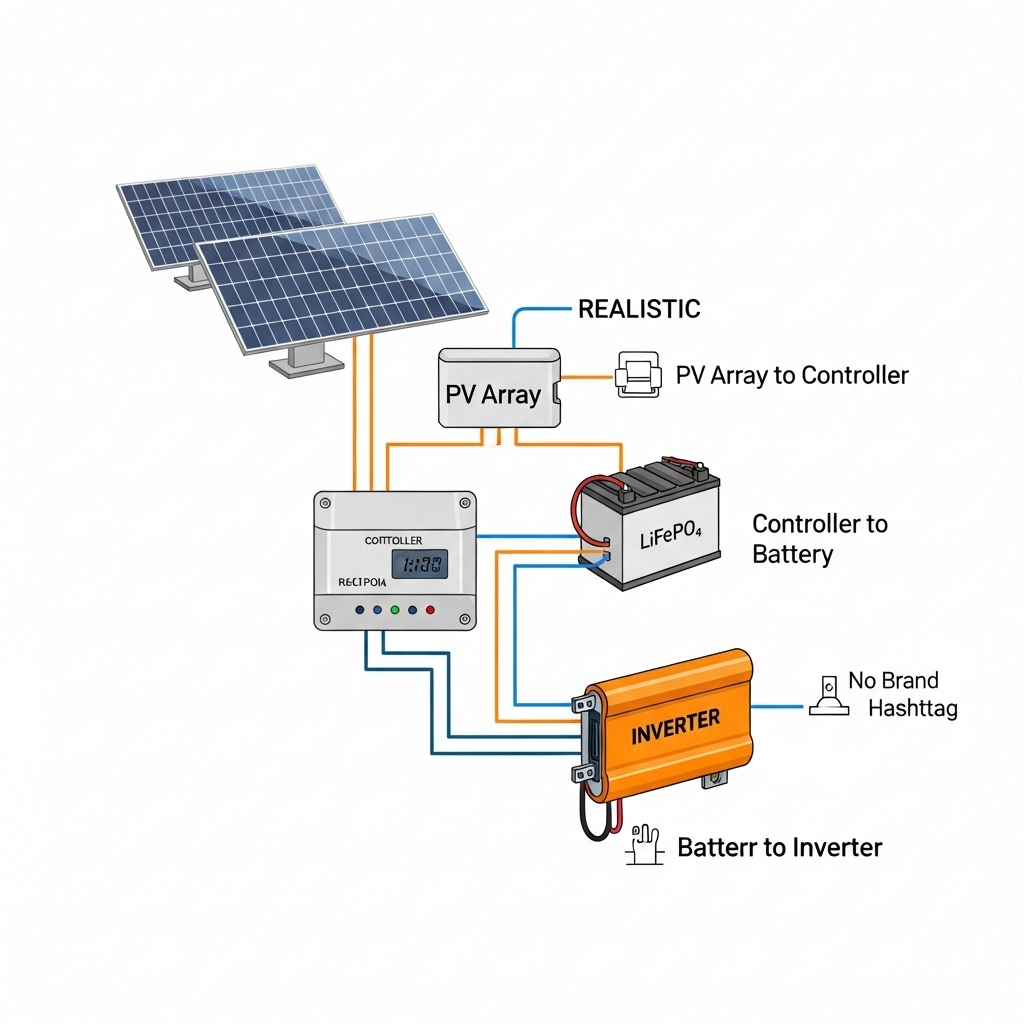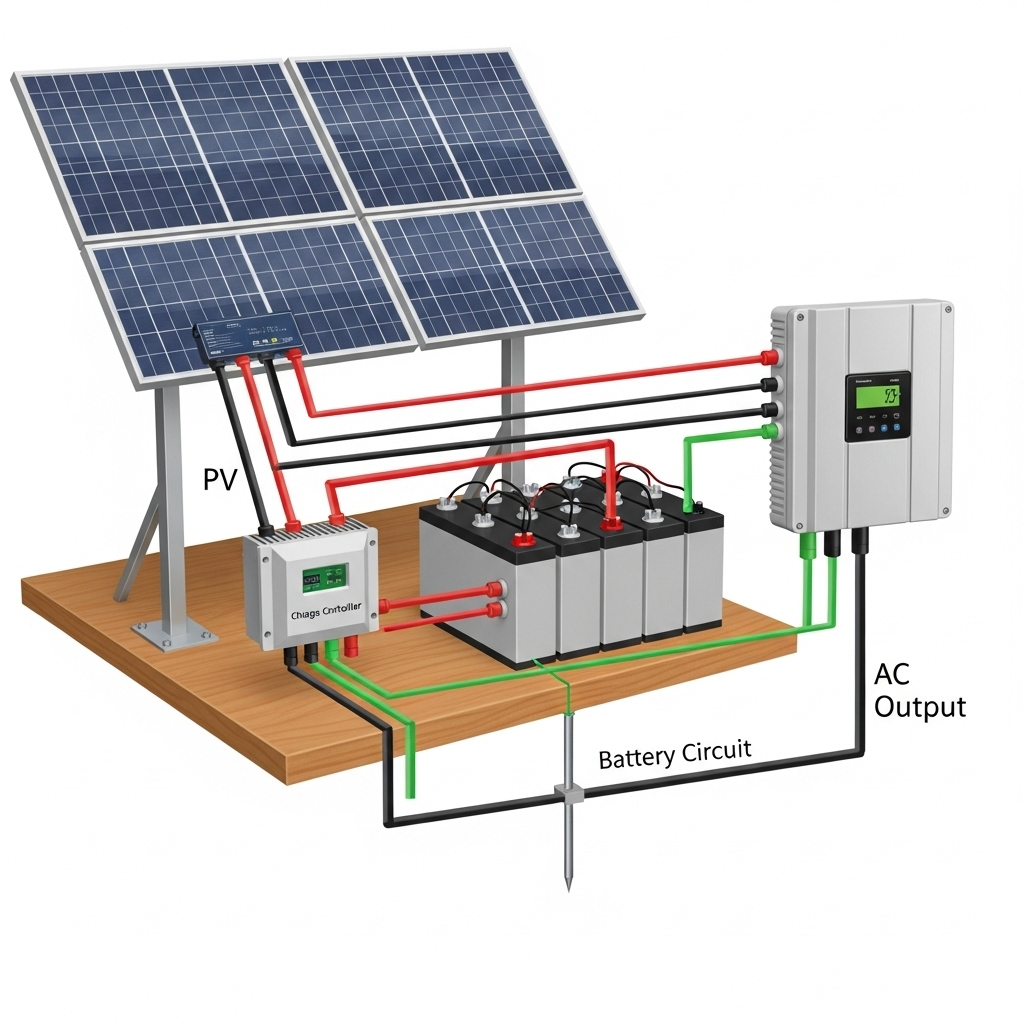The choice between copper and aluminum conductors is a frequent topic in solar system design. Copper has long been the standard, valued for its high conductivity. Yet, aluminum presents a compelling case due to its lower cost and lighter weight. The critical question for any installer or system designer is straightforward: can aluminum cables manage voltage drop effectively within the strict limits required for photovoltaic (PV) systems?
This analysis examines the performance of aluminum conductors in solar applications. We will cover the technical requirements, calculation methods, and practical installation details to determine if aluminum is a viable choice for your project.
Understanding the Core Challenge: Voltage Drop in PV Systems
Managing voltage drop is fundamental to designing an efficient and reliable solar energy system. Ignoring it can lead to significant power loss and equipment malfunction.
What Is Voltage Drop and Why Does It Matter?
Voltage drop is the reduction in electrical potential along the path of a current-carrying wire. As electrons move through a conductor, they encounter resistance, which causes a loss of energy in the form of heat. This results in a lower voltage at the end of the wire compared to the source. In a PV system, excessive voltage drop means less power reaches your inverter, reducing your total energy harvest. It can even cause inverters to fault or shut down if the operating voltage falls below their minimum threshold.
Factors Influencing Voltage Drop
Several factors determine the amount of voltage drop in a circuit. The primary ones are the conductor's material, its cross-sectional area (size or gauge), the length of the wire, and the amount of current flowing through it. Longer runs and higher currents increase voltage drop, while larger conductors decrease it. Industry best practices often recommend keeping DC voltage drop below 2% or 3% to ensure optimal system performance.
Aluminum vs. Copper: A Head-to-Head Comparison for Solar
The decision to use aluminum wiring hinges on understanding its properties relative to copper and how to compensate for the differences.
Resistivity and Conductivity
The main electrical difference between the two metals is resistivity. Aluminum has a higher resistance to electrical flow than copper. Specifically, aluminum possesses about 61% of copper's conductivity. This means that for a given length and size, an aluminum wire will have a higher voltage drop than a copper wire carrying the same current. To overcome this, aluminum conductors must be sized larger than their copper counterparts to achieve the same performance.
Sizing and Ampacity Considerations
To achieve the same low voltage drop as a copper cable, you must use a larger gauge aluminum cable. This practice is known as 'upsizing'. According to a report from the International Energy Agency, aluminum is already commonly used for overhead power lines due to its weight advantage, a principle that can apply to certain solar installations. As noted in the The Role of Critical Minerals in Clean Energy Transitions, demand for aluminum in electricity grids is substantial and growing. The table below shows the approximate aluminum wire size needed to replace a copper one for similar ampacity.
| Copper AWG | Aluminum AWG |
|---|---|
| 10 | 8 |
| 8 | 6 |
| 6 | 4 |
| 4 | 2 |
| 2 | 1/0 |
| 1/0 | 3/0 |
| 2/0 | 4/0 |
Note: This table is a general guide. Always consult the National Electrical Code (NEC) or local regulations for precise ampacity ratings and sizing requirements.
Weight and Cost Implications
Here is where aluminum offers its greatest benefits. Aluminum is approximately 70% lighter than copper for the same volume. Even after upsizing the conductor to match copper's performance, the aluminum cable is often still about 50% lighter. This makes it easier to handle and install, especially in long runs. Furthermore, aluminum is typically less expensive than copper, and these cost savings can be significant on large residential or commercial projects. The push for more solar PV and long-distance power lines, which use substantial amounts of aluminum, underscores its economic importance, as highlighted in the IEA's Energy Technology Perspectives 2024 report.
Practical Application: Can Aluminum Realistically Meet the Limits?
With correct design and installation, aluminum cables can absolutely meet strict PV voltage drop limits. The key is in the planning and execution.
Calculating Voltage Drop for Aluminum Cables
The process for calculating voltage drop is the same for both materials; only the resistivity value changes. Using the correct formula and the specific resistance for aluminum, you can accurately determine the required wire gauge. For example, a 150-foot run with a 12-amp string current might require a 10 AWG copper wire to stay under a 2% drop. To achieve the same performance with aluminum, the calculation would point towards an 8 AWG wire, proving it is entirely feasible to meet the limit.
Where Aluminum Shines: Use Cases in PV Systems
Aluminum is particularly well-suited for certain applications. It is an excellent choice for long feeder runs, such as from a large ground-mounted array back to a building or main service panel. In these scenarios, which can span hundreds of feet, the cost and weight savings are magnified. It is also a preferred material in utility-scale solar farms where thousands of feet of cable are required.
Installation and Termination: The Critical Details
Proper installation is crucial for a safe and durable aluminum wiring system. Aluminum oxidizes when exposed to air, and this oxide layer is not highly conductive. Therefore, an anti-oxidant compound must be applied to all terminations. Additionally, you must use lugs and connectors specifically rated for use with aluminum, typically marked as AL/CU. These components are designed to handle aluminum's greater thermal expansion and contraction, ensuring a secure connection over the system's lifetime.
Integrating System Design for Optimal Performance
Conductor choice does not exist in a vacuum. It is part of a broader system design strategy aimed at maximizing efficiency and return on investment.
The Role of System Voltage
Higher system voltages dramatically reduce voltage drop. Since Power = Voltage x Current, doubling the system voltage (e.g., from a 300V string to a 600V string) cuts the current in half for the same power output. This lower current significantly lessens voltage drop, making it easier for even upsized aluminum conductors to stay well within performance limits. This is one reason modern solar designs trend toward higher DC voltages.
A Holistic View on System Efficiency
Choosing the right conductor is just one piece of the puzzle. The overall performance of a solar and storage system depends on the interplay between panels, inverters, batteries, and wiring. For a comprehensive look at how these different components impact overall efficiency, the Ultimate Reference for Solar & Storage Performance offers valuable data and insights into maximizing your system's output. This broader perspective helps in making informed decisions, like choosing aluminum wiring, that contribute to both financial savings and energy efficiency. As noted in an IRENA publication, wiring can represent a significant portion of installation costs, making material choice an important factor in project economics. The Innovation Outlook: Smart charging for electric vehicles report points out that building wiring can account for up to 50% of charging installation costs, a parallel that highlights the importance of optimizing conductor expenses.
Final Considerations
Aluminum cables can successfully be used in PV systems and meet stringent voltage drop requirements. The choice is not a simple one of good versus bad, but rather a technical and economic trade-off. By upsizing the conductor and following strict installation protocols, you can leverage the significant cost and weight advantages of aluminum without compromising system safety or performance. The final decision rests on a careful evaluation of your project's specific needs, budget, and design parameters.
Frequently Asked Questions
Is aluminum wire as safe as copper for solar panels?
Yes, when installed correctly. Safety depends on proper sizing, using AL/CU rated connectors, and applying an anti-oxidant compound at terminations to prevent corrosion. Adhering to all applicable electrical codes is essential for a safe installation.
How much bigger does an aluminum cable need to be compared to copper?
As a general rule, you typically need to select an aluminum conductor that is two sizes larger (AWG) than its copper equivalent to achieve a similar current-carrying capacity (ampacity). For precise voltage drop calculations, always use a dedicated calculator and refer to code standards.
Can I connect aluminum wire directly to my solar inverter?
You must check the inverter's documentation and the markings on its terminals. The connection points must be explicitly rated for aluminum conductors, often marked AL/CU. If they are not, you cannot connect aluminum directly and may need to use a special transition block to splice to a short length of copper wire before the final connection.
Does aluminum wire require more maintenance?
A properly installed aluminum connection should not require more maintenance than a copper one. The quality of the initial installation is the most important factor. Ensuring that all connections are clean, tight, and protected with an anti-oxidant compound prevents issues from developing over the system's lifespan.





Leave a comment
All comments are moderated before being published.
This site is protected by hCaptcha and the hCaptcha Privacy Policy and Terms of Service apply.